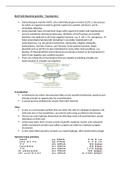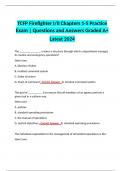BLGY1232 Bacterial genetics - Transduction
Horizontal gene transfer (HGT), also called lateral gene transfer (LGT), is any process
by which an organism transfers genetic material to another cell that is not its
immediate offspring
Some plasmids have a broad-host range (with regard to transfer and maintenance)
and are sometimes termed promiscuous; Members of IncP1 group can transfer
between and replicate in all Gram-negative bacteria, e.g. E. coli => Ps. aeruginosa;
Most enterobacterial plasmids (including F) are stably maintained in all
enterobacteria, e.g. the genera Escherichia, Salmonella, Shigella, Klebsiella,
Enterobacter, Serratia, Proteus, and Yersinia; Gram-positive bacteria: Staph.
plasmids such as pC194 are also maintained in many other Gram-positives, e.g.
Bacillus Plasmid pIP501 from Enterococcus faecalis is known to be maintained in
both Gram-negative and -positive bacteria
There are a diversity of mechanisms that are capable of planting virtually any
bacterial gene in virtually any organism
Transduction
A mechanism by which chromosomal DNA can be transferred between bacterial and
thereby provide an opportunity for recombination
A sexual process mediated by viruses that infect bacteria
Virus
A virus is a microscopic particle that can infect the cells of a biological organism. All,
with only one or two exceptions, can only be seen using an electron microscope
Viruses can only replicate themselves by infecting a host cell and therefore cannot
reproduce on their own
At the most basic level, viruses consist of genetic material/ nucleic acid contained
within a protective protein coat called a capsid (can often be relatively complex
structures)
A virus that infects bacteria is known as a bacteriophage, often shortened to phage
Genome types and sizes
, MS2: 1 capsid protein and 3.6 k nts of RNA; it’s a regular icosahedron which has
equilateral triangles as faces , the capsids of MS2 and other viruses can self-assemble
in vitro and there is hope that they can be developed as molecular submarines –
perhaps field is now being nominated by nanoparticles
The capsids of some viruses are made from more than one protein and form
relatively complex structures/machines – nature’s nanomachines
Phages
Bacteria are parasitized/infected by a large variety of viruses
Will deal with only coliphagetwo types of - T4 and lambda, both of which happen to
have a double-stranded DNA genome
Coliphages are viruses that infect E. coli
Virulent (T2 and T4) – leads to phage multiplication and host death
Portals
The surface molecules that serves as receptors for bacteriophage do not exist
merely as portals for entry of phage They serve some other important
function e.g. M13 is 'male-specific ‘, i.e it utilises the E. coli F pilus for
infection
The receptor for phage lambda (l) is LamB, a member of the sugar porin
family that facilitates the diffusion of maltose (and other maltodextrins)
across the outer membrane
The receptor for T4 and other T even phage is OmpA, which is another porin;
it provides a pathway for the diffusion of small hydrophilic compounds in and
out of the cell
Phages vary in their host ranges
Phage therapy
Horizontal gene transfer (HGT), also called lateral gene transfer (LGT), is any process
by which an organism transfers genetic material to another cell that is not its
immediate offspring
Some plasmids have a broad-host range (with regard to transfer and maintenance)
and are sometimes termed promiscuous; Members of IncP1 group can transfer
between and replicate in all Gram-negative bacteria, e.g. E. coli => Ps. aeruginosa;
Most enterobacterial plasmids (including F) are stably maintained in all
enterobacteria, e.g. the genera Escherichia, Salmonella, Shigella, Klebsiella,
Enterobacter, Serratia, Proteus, and Yersinia; Gram-positive bacteria: Staph.
plasmids such as pC194 are also maintained in many other Gram-positives, e.g.
Bacillus Plasmid pIP501 from Enterococcus faecalis is known to be maintained in
both Gram-negative and -positive bacteria
There are a diversity of mechanisms that are capable of planting virtually any
bacterial gene in virtually any organism
Transduction
A mechanism by which chromosomal DNA can be transferred between bacterial and
thereby provide an opportunity for recombination
A sexual process mediated by viruses that infect bacteria
Virus
A virus is a microscopic particle that can infect the cells of a biological organism. All,
with only one or two exceptions, can only be seen using an electron microscope
Viruses can only replicate themselves by infecting a host cell and therefore cannot
reproduce on their own
At the most basic level, viruses consist of genetic material/ nucleic acid contained
within a protective protein coat called a capsid (can often be relatively complex
structures)
A virus that infects bacteria is known as a bacteriophage, often shortened to phage
Genome types and sizes
, MS2: 1 capsid protein and 3.6 k nts of RNA; it’s a regular icosahedron which has
equilateral triangles as faces , the capsids of MS2 and other viruses can self-assemble
in vitro and there is hope that they can be developed as molecular submarines –
perhaps field is now being nominated by nanoparticles
The capsids of some viruses are made from more than one protein and form
relatively complex structures/machines – nature’s nanomachines
Phages
Bacteria are parasitized/infected by a large variety of viruses
Will deal with only coliphagetwo types of - T4 and lambda, both of which happen to
have a double-stranded DNA genome
Coliphages are viruses that infect E. coli
Virulent (T2 and T4) – leads to phage multiplication and host death
Portals
The surface molecules that serves as receptors for bacteriophage do not exist
merely as portals for entry of phage They serve some other important
function e.g. M13 is 'male-specific ‘, i.e it utilises the E. coli F pilus for
infection
The receptor for phage lambda (l) is LamB, a member of the sugar porin
family that facilitates the diffusion of maltose (and other maltodextrins)
across the outer membrane
The receptor for T4 and other T even phage is OmpA, which is another porin;
it provides a pathway for the diffusion of small hydrophilic compounds in and
out of the cell
Phages vary in their host ranges
Phage therapy








